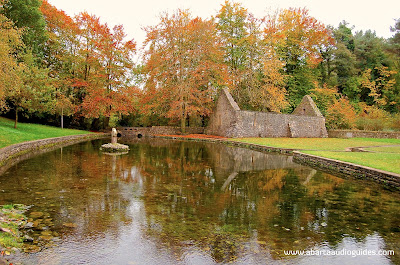St. Patrick's Well is situated in a tranquil valley to the west of Clonmel, close to the village of Marlfield in County Tipperary. It is a beautiful setting for this holy site which has been revered for centuries. There are over 3,000 holy wells in Ireland and St. Patrick's Well is thought to be one of the largest in the country. Holy wells are sacred places where natural springs or man-made hollows that collect water are thought to have a religious significance because of their association with a saint.
At St. Patrick's well, legend has it that St. Patrick stopped off at this valley on his journey through South Tipperary and Waterford where he reputedly converted the King of Munster to Christianity at the Rock of Cashel. St. Patrick was reputed to have stopped here to bathe and baptise local people, however it is unlikely that Patrick was ever in this part of Ireland, as he does not mention travelling to the south of the country in his writings Confessio or Letter to the Soldiers of Coroticus, in fact the story of Patrick's journey in Munster comes from a source written nearly five hundred years after Patrick's death – the 10th Century Life of St. Declan, but despite this, St. Patrick’s association with the well lives on to this day.
Like many Holy wells around the country, St. Patrick’s Well is said to have many curative properties in local belief and folklore. It is said that by drinking the water from the well or even washing in the well, ailments like sore lips, sore eyes and many other chronic diseases can be cured. Indeed, it is thought that the well at St. Patricks has magical properties as the water that flows through the well never freezes, this is more likely due to the fact that the well is sited over natural springs that maintain a constant temperature.
The Well itself has been enclosed by a circular wall. The natural water that bubbles up is channeled through two narrow stone cut openings that an archaeologist has identified as possible flumes from an early medieval mill. The water descends into a large shallow pool, from where it then flows into a narrow stream, a tributary of the River Suir, which flows about a couple of kilometres south of the site.
Standing on a small island in the pool is the small sandstone cross, thought to be one of the oldest archaeological monuments at St. Patrick's Well. This cross is thought to date to the 8th century. It was originally positioned close to the church on marshy ground, but a programme of renovation and reconstruction was carried out at this site in the 1960's and the cross was moved to its current position.
The stone church which stands to the south appears to date to the fifteenth or sixteenth century. There is a historical record of the Abbot of Inislounaght being buried at the church in 1617. Inislounaght was once a thriving bustling Cistercian Abbey but there are no traces left of the Abbey today. However, it is thought that some architectural fragments were brought from the Abbey to St. Patrick's Well and incorporated into the parish church. Within the now roofless Parish church there is an altar tomb dating from 1622, dedicated to the White family.
St. Patrick’s Well is a great example of this type of archaeological monument that transcends the boundaries between Paganism and Christianity. If you visit this peaceful and tranquil spot it is easy to see why it was chosen hundreds or even thousands of years ago as a place of worship as there is a clear connection between the natural and sacred world at this site.
The easiest way to get to St. Patrick's well is to take the left hand turn after the Poppyfields shopping centre on the Cahir Road. Follow this narrow road until you come to a crossroads, turn right and continue on this road, there will be parking spaces to your left and the Well is accessed through a brightly painted gate. There are signposts leading to the site. Access to the well is down a number of steps which bring you down into the sheltered valley. If you have time, visit Marlfield lake which is close by, this is a man-made lake which is now home to a wild bird sanctuary.
If you like our images you may be interested to know that we offer a selection for sale at http://www.12greengiraffes.com/abarta.html including an image of the serene St. Patrick's Well.



